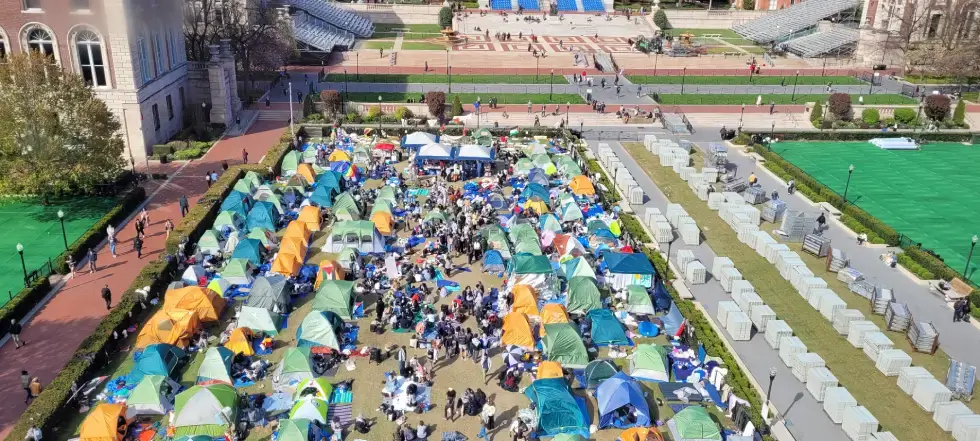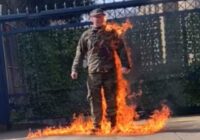I graduated from Columbia University, in New York’s Morningside Heights, at the beginning of this year. I’ve been expecting to wear the oft-Instagrammed blue robes in less than two weeks — not considering the alternate reality I was about to see unfold before my eyes. Nor did I think that I would ever see hundreds of New York Police Department officers flood into the campus in riot gear, forcibly putting an end to the demonstrations.
Because I live off-campus, I had been following the pro-Palestinian student protests that began on April 17 through the news and a few visits on campus. I watched as tensions escalated, but I never thought that they would reach the point that they have. On Tuesday, April 30, I sat on the floor of my home and watched the CBS News YouTube live stream, aghast, as policemen filed one-by-one into a Hamilton Hall window. They had been sent by Columbia’s administration to extricate students who barricaded the building. Outside, a crowd yelled, “Shame!” The scene looked like a sci-fi show.
This article is not an argument against peaceful protests. There are already more than enough op-eds to start a conversation. Nor am I here to defend the Israeli cause. I am of multi-ethnic descent; I am neither a Jew nor an Arab or Muslim. I do not have religious or blood ties to represent either side. But I am a native New Yorker and a Columbia student, and I feel sadness at what has happened to our beautiful global community. I would like to ask a simple but difficult question: How did we get here? How did we get to April 30?
From student protest to chaos
After Israel–Hamas war broke out on October 7, 2023, I spent half a week scrolling through the news. I was not the only person on campus disturbed by the unfolding events. A fellow student interrupted one of my classes multiple times to promote the pro-Palestinian protests she was organizing on campus. I took a glimpse at her tablet. She was on Facebook communicating with several people who were not, from what I could tell, part of the Columbia community. NYC Mayor Eric Adams later confirmed that outsiders contributed to the riots.
When more than one member of the class questioned this activist, she would not acknowledge Hamas’ October 7 attacks for what they were — an orchestrated act of terrorism by an extremist group that seeks to eradicate Israel and has committed brutality against Palestinians. Instead, she justified the atrocities, calling them a proportionate response to genocide.
We are now over six months into the war. Although it is all but impossible to know how many Palestinians have been killed, we can be certain that a sickeningly high proportion of the tens of thousands of deaths have been of women, children and other non-combatants. By and large, the Columbia students who have protested, like people of conscience worldwide, stand in solidarity with civilians who are not synonymous with their government. Yet much of the rhetoric we have heard over the past two weeks veers from righteous condemnation into a spirit of indiscriminate wrath.
On April 30, protestors shouted “Intifada!” breaking down the doors of Hamilton Hall with their faces concealed. They justified their actions as a response to the university administration’s refusal to sell off investments in Israeli companies as they had demanded. Their peaceful protest turned into destruction of school property.
Hate and intimidation on campus
We should have known, considering how protest leaders like Khymani James publicly asserted: “Zionists don’t deserve to live,” that the demonstration was going off the rails. Perhaps the phrase was intended as a performative act of rhetoric. Regardless, its invocation of violence remains material. Even if no one is actually harmed, it is dangerous and irresponsible to inculcate a student culture where intimidating behavior is lauded as revolutionary.
In this environment, it seems that people cannot be angry over a certain injustice without losing all human feeling about others. Students have been calling Israel “the new Nazi Germany,” either recklessly or callously invoking the most painful episode of all Jewish history to use it as leverage in campus protests. Just 80 years ago, Nazis hunted down Jews across Europe and imprisoned, enslaved and tortured them in concentration camps, finally killing six million of them with appalling brutality. To exploit that memory — especially in a time when thousands of Holocaust survivors, with their children and grandchildren, are still alive — is unconscionable.
Language that invokes and even encourages violence against Jews regardless of the motivation puts Jewish students and, frankly, any students who have been the victims of prejudice in fear of bodily harm. On the street, this would be bad enough. In a place that is supposed to be a safe haven for intellectual freedom and a second home to students, it is a travesty. A professor who used defamatory language would get fired. But some protestors feel free to let loose whatever vitriol is in their hearts, and then they will call it a “false narrative” if you ask them to explain their choice of words.
As it turns out, the fears of Jewish students have not been misplaced. In a video posted to Twitter on April 21, hundreds of student protesters close a “human chain” around Jewish students, attempting to drive them off campus. James, their leader, said there were Zionists among them. The process was reminiscent of a cult rite, with students obeying as the leader chanted out commands. These actions did nothing to further the protestors’ cause. They were nothing more than an act of bullying.
Reaching a middle ground
I could go on, but I’m going to stop here and get to the point. Student protestors insist their demonstrations are peaceful. But from what we saw Tuesday night, they have become more serious. Anger and disappointment are not likely to dissipate soon. We can talk about it and compromise. Columbia’s failure to divest is not reason for tearing up the campus, spewing hateful rhetoric, frightening students who are stuck living in the dorms, and making it hard for low-income students to access dining halls when the former Gaza solidarity encampments had a buffet. Nor is hate speech helping to positively shape American public opinion.
The campus is our shared responsibility as students. There is no justification for violence at Columbia, a place for people from all walks of life. No one — student, worker, passerby — should be afraid here. We need to stop the escalation of protests before a single tragedy happens in our community.
Anyone who protests war is justified and deserves respect. Yet we college students have the privilege of learning. There must be better ways to protest the war and protest cruelty with our education and compassion.
[Anton Schauble edited this piece.]
The views expressed in this article are the author’s own and do not necessarily reflect Fair Observer’s editorial policy.
Support Fair Observer
We rely on your support for our independence, diversity and quality.
For more than 10 years, Fair Observer has been free, fair and independent. No billionaire owns us, no advertisers control us. We are a reader-supported nonprofit. Unlike many other publications, we keep our content free for readers regardless of where they live or whether they can afford to pay. We have no paywalls and no ads.
In the post-truth era of fake news, echo chambers and filter bubbles, we publish a plurality of perspectives from around the world. Anyone can publish with us, but everyone goes through a rigorous editorial process. So, you get fact-checked, well-reasoned content instead of noise.
We publish 2,500+ voices from 90+ countries. We also conduct education and training programs
on subjects ranging from digital media and journalism to writing and critical thinking. This
doesn’t come cheap. Servers, editors, trainers and web developers cost
money.
Please consider supporting us on a regular basis as a recurring donor or a
sustaining member.
Will you support FO’s journalism?
We rely on your support for our independence, diversity and quality.








Comment